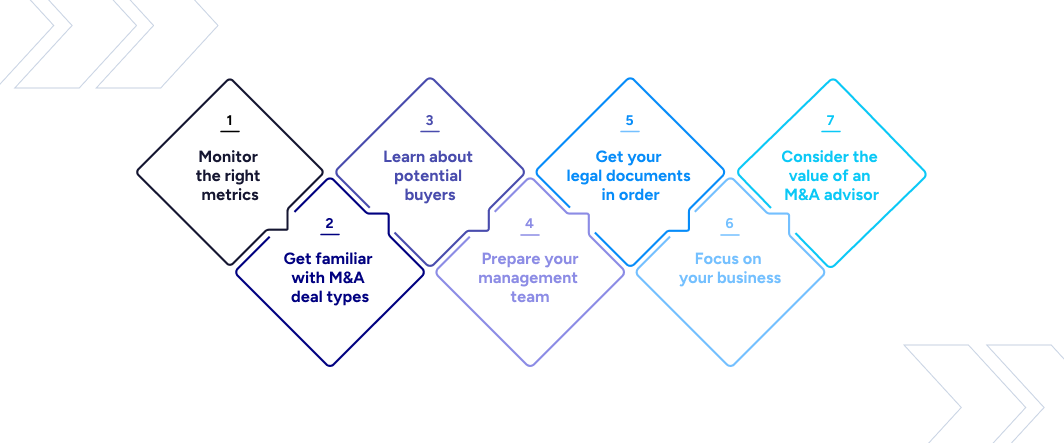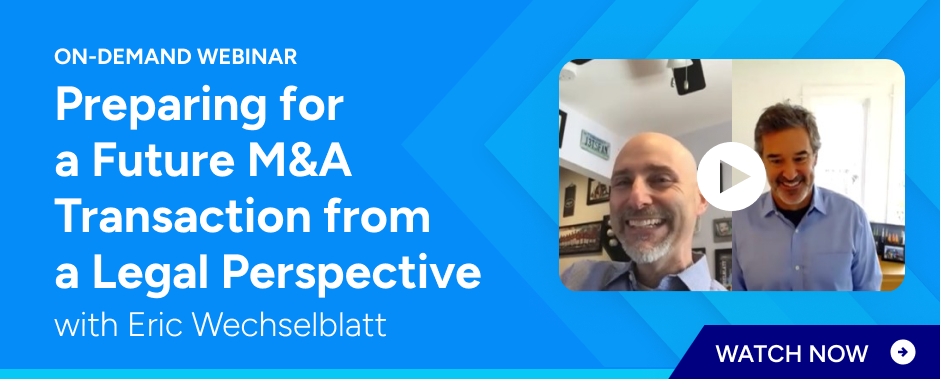How to Prepare an Exit Strategy: A Guide for SaaS Founders

The following content has been refreshed as of February 2024.
Building and scaling a successful SaaS business is a tremendous achievement in itself. But the time may come when you want to reap the rewards of your hard work and achieve some liquidity by selling a significant portion, or all, of your business. Preparing an exit strategy is an essential exercise to bring that goal to fruition, and the sooner you start, the better. A thorough exit strategy planning process will help you understand your options, define your objectives, get the right metrics and documents in order, and identify areas for improvement that could help you attract a buyer and increase your valuation in an M&A exit.
At SEG, it’s our business to advise SaaS entrepreneurs on their M&A exit strategies. Here are seven steps we recommend to put your company’s best foot forward:
1. Monitor the right metrics.
You’re probably already tracking certain key performance indicators (KPIs) in your day-to-day operations. But are they the same KPIs prospective buyers look at as they evaluate acquisition targets? In recent years, software buyers have been keenly focused on gross revenue retention (GRR) and gross profit margin (GPM), largely because strong performance in these areas provides security amid uncertain economic conditions. You can improve your GRR and GPM by staying focused on your highest-margin customer relationships and continuing to acquire similar customers while keeping costs low. Other KPIs buyers will likely ask about include monthly and annual recurring revenue, churn rate, and customer acquisition costs. Optimizing these figures and being able to report them accurately will make the M&A exit process much smoother.
2. Get familiar with M&A deal types.
To plan a proper exit, you should know there’s more than one way to sell your company. In the SaaS world, most M&A deals fall into one of these categories:
- Strategic acquisition: when a larger company purchases a smaller one outright, usually to acquire its technology and customers. In some cases, the owners of the acquired company walk away with no future involvement. In others, they stay on to continue managing their company as a subsidiary of the new owners.
- Horizontal merger: when two companies in the same industry or market segment join forces to create a bigger company, often establishing one clear leader in the space.
- Majority recapitalization: when the acquirer (typically a PE firm) buys a majority stake in a company. Instead of an all-cash payout, the owners of the acquired company accept an equity stake in the new entity as part of the deal. Also known as “rollover equity,” this arrangement can produce a second lucrative payday when the PE firm resells the company several years later.
- Roll-up acquisition: when one organization acquires multiple companies in a short time. Sometimes, PE firms will use this strategy to acquire several smaller software businesses that they can combine to create economies of scale.
You can learn more about each deal type in this post. The best exit strategy for your company will depend on your personal and business goals, the type of software your company offers, the industry you serve, and the competitive landscape.
3. Learn about potential buyers.
Just as there are different types of deals, there are different types of buyers who might be interested in your company. Most buyers can be grouped into one of two categories: strategic buyers and financial buyers.
- Strategic buyers want to acquire your company to make theirs stronger. Their intentions may include acquiring your software to complement their existing offerings, expanding into new markets, or simply eliminating a key competitor by taking them over. Strategic buyers may be publicly traded or privately held companies, including other software companies or larger, diversified organizations in the vertical you serve.
- Financial buyers, usually PE firms, are not interested in integrating your company with their own. Rather, their purpose is to acquire your company, make it bigger and better, and then sell it to another party when the time is right. PE firms typically have significant experience working with similar software companies, and their management team can help grow the company and enhance its performance. Ultimately, they want to increase the company’s valuation and create another lucrative exit opportunity for themselves and (if they bought the company through a majority recapitalization) the original owners.
As you think about how to prepare an exit strategy, it’s wise to think like a buyer, understand their motivations, and how your company might meet their needs.
4. Prepare your management team.
Months, or even years, before you start working to sell your company, you need to have a strong management team in place. Even though you’re intimately familiar with the inner workings of your own company, you can only spread yourself so thin, and scaling the business will likely require additional expertise you can’t provide. Key members may include a chief financial officer (CFO), a chief technology officer (CTO), a VP of sales, and perhaps human resources and marketing executives. Having an experienced and firmly established management team will not only help you grow the business more profitably, but it will also be invaluable when it comes time to execute your exit strategy, market your company for sale, and assemble all required information to complete the deal.
5. Get your legal documents in order.
Any M&A transaction will involve a lengthy and painstaking process to gather and verify a wide range of legal documentation. While these documents won’t be finalized until it’s time to seal the deal, it’s never too early to start putting the right pieces in place. Consult with your legal team well in advance of any M&A activity to avoid cleaning up documents or collecting signatures at the eleventh hour.
In a virtual coffee discussion, SEG Managing Partner Allen Cinzori and Eric Wechselblatt, a Partner at Holland & Knight, discussed the top four things SaaS executives can do today to prepare for an exit from a legal perspective. They highlighted four key areas to prepare for: employees, technology, customers and contracts, and taxes. Watch the full discussion to learn more about each topic:
6. Focus on your business.
While the prospect of an M&A exit is exciting, make sure it doesn’t come at the expense of business as usual. After all, buyers will lose interest if your company’s current performance is faltering. By continuing to focus on growth, cost control, product differentiation and competitive positioning, you and your management team will ensure the company is in the best possible position for a sale.
7. Consider the value of an M&A advisor.
There’s no way around it – selling a company is an extremely complex, time-consuming, and potentially overwhelming process. Chances are you, as the founder and/or CEO, are either too busy to cover all the bases correctly or too close to the company to assess its value objectively. That’s why most companies enlist the help of an M&A advisor like SEG. The M&A process may be new to you, but we’ve been through it hundreds of times with other SaaS companies much like yours. We can look at your business from a buyer’s point of view, guide you toward making the right improvements to enhance your valuation, and help you develop and carry out a realistic and rewarding exit strategy.
Not sure how to prepare an exit strategy? Reach out to SEG to request a consultation.










